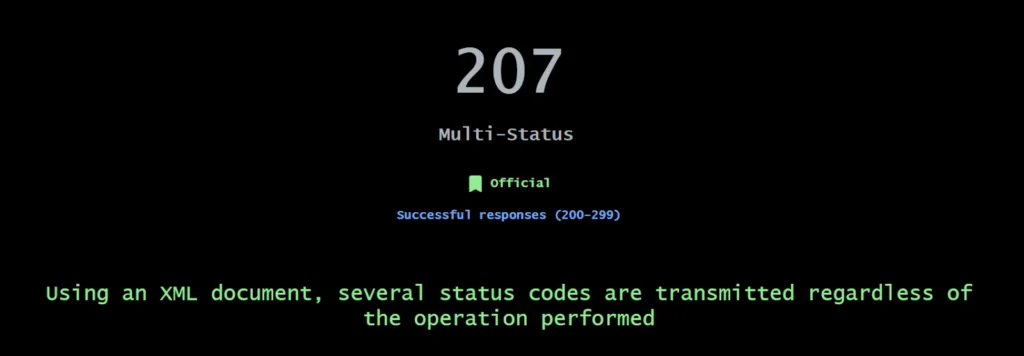HTTP status codes help describe the outcome of a client’s request to a server. While most are familiar with common codes like 200 or 404, others, like the 207 status code, play a specialized yet important role in specific applications.
The 207 Multi-Status code is not a generic response; it’s typically used in WebDAV-enabled environments and advanced APIs where multiple operations must be evaluated simultaneously.
For business owners managing complex platforms or working with large-scale CMS or cloud services, understanding how 207 works is key to better error handling and performance optimization.
What Is the 207 Status Code?
The 207 status code, officially labeled as “Multi-Status,” is part of the WebDAV (Web Distributed Authoring and Versioning) protocol extension to HTTP.
Unlike single-response status codes like 200 or 404, 207 is used to return information about multiple resources in one consolidated response. This is particularly useful when a request applies to several resources simultaneously, such as moving or deleting a batch of files.
When a 207 response is issued, the body of the response includes an XML document, containing a list of status codes corresponding to each resource involved.

Image Source: HTTP-Statuscode.com
Each item’s outcome (success, failure, or partial success) is defined individually, providing granular detail without requiring multiple round trips.
It makes 207 highly efficient in batch processing operations and ideal for scalable web infrastructure where high-volume interactions with resources occur frequently. It is not an error code but a structured response format for multi-object transactions.
When and Why Is It Used?
The 207 status code is designed for scenarios where a single HTTP request affects multiple resources. Rather than issuing several separate responses, a server can respond with a 207 to detail the status of each resource in a unified, multi-part XML format.
This streamlines client-server communication, especially in environments where resource management is critical.
It is most commonly seen in WebDAV-based systems but is also used in some RESTful APIs that perform batch actions. By using 207, developers reduce latency, improve request efficiency, and allow clients to parse multiple outcomes in a single operation.
This is valuable for enterprise tools, cloud services, or backend management systems that handle large sets of content or files at once.
Common scenarios include:
- Deleting multiple documents in a content management system
- Moving files in a WebDAV-enabled cloud drive
- Updating metadata for several media assets at once
- Synchronizing directories across distributed systems
207 vs Similar Status Codes
While the 207 status code is part of the 2xx success category, it differs significantly from others by offering multi-resource reporting. The table below outlines how it compares to common 2xx responses.
| Status Code | Name | Response Type | Use Case |
| 200 | OK | Single success | Standard response for successful GET |
| 201 | Created | Single success | Indicates resource creation |
| 204 | No Content | Single success | Action completed with no return body |
| 207 | Multi-Status | Multi-resource success report | Batch processing or WebDAV interactions |
A common misconception is confusing 207 with “207 Partial Success.” The latter is unofficial and not a recognized HTTP code. 207 does not indicate partial failure. It is a structured success response where each resource’s status (successful or otherwise) is reported in XML.
Importantly, 207 itself is not an error but a holistic and detailed response for multi-target operations.
How to Handle 207 Responses
Handling 207 responses requires structured parsing and resource-level error detection. Developers and system architects should consider the following:
- Parse the XML response to retrieve individual status codes for each resource.
- Ensure the client application can handle mixed outcomes (e.g., partial successes and failures).
- Log and monitor response patterns to detect recurring resource-specific issues.
- When applicable, retry operations only on failed resources instead of resending the entire batch.
- Display or store per-resource results to provide transparency for users or system logs.
Because 207 enables greater transactional clarity, treating each node in the response with autonomy will help build more resilient backend processes.
Best Practices and Considerations
When using or responding to 207 status codes, the following best practices help ensure reliability:
- Always validate and sanitize XML payloads before processing.
- Avoid using 207 in non-multi-resource scenarios where a simpler 2xx code suffices.
- Align server-side logic to ensure each resource status is accurately reported.
- Document how your system handles 207 for internal and third-party integrations.
- Prefer explicit mapping between resources and response statuses in APIs.
These measures can help mitigate ambiguity and ensure consistent implementation across development and operations teams.
Conclusion
The 207 status code is a specialized tool that simplifies complex HTTP transactions involving multiple resources. It improves transparency and efficiency, especially in environments that rely on WebDAV or batch operations.
While underutilized in many mainstream applications, it provides powerful handling and response mechanisms for advanced systems.
Understanding its structure and appropriate use cases can enable business platforms to optimize workflows, reduce API round-trips, and improve communication clarity between clients and servers at scale.


